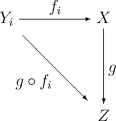Final topology
In general topology and related areas of mathematics, the final topology (or strong topology or colimit topology or inductive topology) on a set  , with respect to a family of functions into
, with respect to a family of functions into  , is the finest topology on X which makes those functions continuous.
, is the finest topology on X which makes those functions continuous.
The dual notion is the initial topology.
Definition
Given a set  and a family of topological spaces
and a family of topological spaces  with functions
with functions
the final topology  on
on  is the finest topology such that each
is the finest topology such that each
is continuous.
Explicitly, the final topology may be described as follows: a subset U of X is open if and only if  is open in Yi for each i ∈ I.
is open in Yi for each i ∈ I.
Examples
- The quotient topology is the final topology on the quotient space with respect to the quotient map.
- The disjoint union is the final topology with respect to the family of canonical injections.
- More generally, a topological space is coherent with a family of subspaces if it has the final topology coinduced by the inclusion maps.
- The direct limit of any direct system of spaces and continuous maps is the set-theoretic direct limit together with the final topology determined by the canonical morphisms.
- Given a family of topologies {τi} on a fixed set X the final topology on X with respect to the functions idX : (X, τi) → X is the infimum (or meet) of the topologies {τi} in the lattice of topologies on X. That is, the final topology τ is the intersection of the topologies {τi}.
- The etale space of a sheaf is topologized by a final topology.
Properties
A subset of  is closed/open if and only if its preimage under fi is closed/open in
is closed/open if and only if its preimage under fi is closed/open in  for each i ∈ I.
for each i ∈ I.
The final topology on X can be characterized by the following universal property: a function  from
from  to some space
to some space  is continuous if and only if
is continuous if and only if  is continuous for each i ∈ I.
is continuous for each i ∈ I.

By the universal property of the disjoint union topology we know that given any family of continuous maps fi : Yi → X there is a unique continuous map
If the family of maps fi covers X (i.e. each x in X lies in the image of some fi) then the map f will be a quotient map if and only if X has the final topology determined by the maps fi.
Categorical description
In the language of category theory, the final topology construction can be described as follows. Let Y be a functor from a discrete category J to the category of topological spaces Top which selects the spaces Yi for i in J. Let Δ be the diagonal functor from Top to the functor category TopJ (this functor sends each space X to the constant functor to X). The comma category (Y ↓ Δ) is then the category of cones from Y, i.e. objects in (Y ↓ Δ) are pairs (X, f) where fi : Yi → X is a family of continuous maps to X. If U is the forgetful functor from Top to Set and Δ′ is the diagonal functor from Set to SetJ then the comma category (UY ↓ Δ′) is the category of all cones from UY. The final topology construction can then be described as a functor from (UY ↓ Δ′) to (Y ↓ Δ). This functor is left adjoint to the corresponding forgetful functor.
See also
References
- Willard, Stephen (1970). General Topology. Addison-Wesley Series in Mathematics. Reading, MA: Addison-Wesley. Zbl 0205.26601.. (Provides a short, general introduction in section 9 and Exercise 9H)


